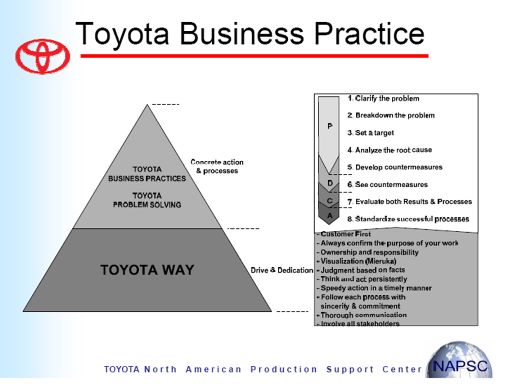The Toyota Business Practice
Jun 27, 2019 • 31 views
Toyota, a Japan based multinational automotive company is not just another automobile company, it is altogether an ideal for its way of management and execution. With a very large employee base and an even larger customer based spread across the world, it has been successful in adding a smile to many faces. It is now one of the top companies of the world, and with greater name comes greater responsibility and with greater responsibility follows greater number of problems and more than that greater number of solutions. Toyota developed its own way of handling the problems it might face, one of the most successful practices of all times.

Also known as the Toyota Business Practice, it consists of 8 steps to solve every problem it faces:
1.Clarify the problem: Any problem one faces, might not be what it appears to. Thus, understanding the actual problem is the matter of prime concern.
2.Breakdown the problem: The biggest of companies face the biggest of issues. Each issue is made up of not one, but a number of small problems. Breaking down that one big problem into smaller more realistic problems makes it easier to understand it.
3.Set a target: Targets which are generally classified into short term goals and the long term goals are the first step that one must take towards resolving an issue. A series of these goals together form the target to solve every issue at hand.
4.Analyse the root cause: Problems are like icebergs, only 1% visible and 99% under the sea ready to come up as soon as the top disappears. Cutting a weed wouldn’t clean your garden, you must remove it from its root. Similarly, treating the problem wouldn’t mean it cannot be caused again. To end a problem on and for all, knowledge of the root cause is ever required.
5.Develop countermeasures: Well, attending to the issue has always been our prime motive. Thus, one must develop the counter measures to treat the problem not only as it is visible but upto its root cause.
6.See countermeasures through: Every action has an equal and opposite reaction and we must ensure is that your actions should not have a negative reaction to it.
7.Evaluate both results and processes: Evaluation is the most important part of a decision as it helps you understand if your decisions will actually work in the scenario.
8.Standardise successful procedures: After such a long process, there are thin chances that you don’t find a successful measure. So once you find it, just standardise it to deal with the problem at hand.
Many big businesses have gained success following the Toyota Business Practice. It’s the time for you to take your first step into the world of this long yet helpful process.
